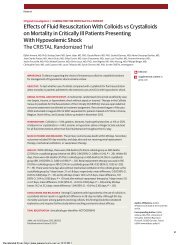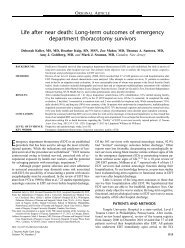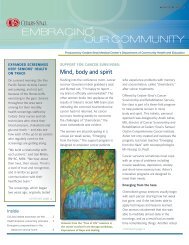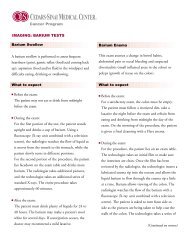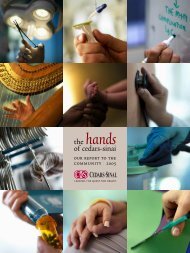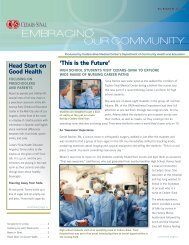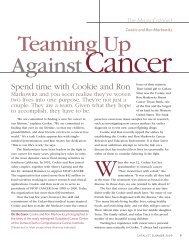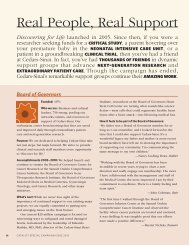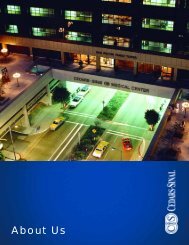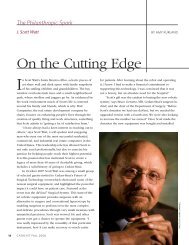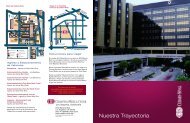A Father's Quest for Answers - Cedars-Sinai
A Father's Quest for Answers - Cedars-Sinai
A Father's Quest for Answers - Cedars-Sinai
You also want an ePaper? Increase the reach of your titles
YUMPU automatically turns print PDFs into web optimized ePapers that Google loves.
The Philanthropic Spark<br />
Robert Lagay and Lazard Capital Markets<br />
A Father’s <strong>Quest</strong><br />
<strong>for</strong> <strong>Answers</strong><br />
When Ryan was born at Princeton Medical<br />
Center in Princeton, New Jersey, in 2006,<br />
his parents, Robert and Cheryl Lagay,<br />
immediately noticed that something was not right with<br />
their baby son: His little legs were dark blue, his feet were<br />
raised up to his ears, and both femurs were dislocated,<br />
which made his kneecaps stick out through the back of<br />
his legs. “I never expected him to walk,” says his father.<br />
Ryan was born with Larsen syndrome, a rare<br />
genetic disorder with an incidence of about one in<br />
100,000 births, whose characteristics are marked joint<br />
hypermobility, congenital dislocations, and distinctive<br />
facial features. At 5 days old, Ryan’s dislocated femurs<br />
were set, and his legs were cast at a slight bend. More<br />
castings followed—each designed to hold the legs at a<br />
greater degree of bend so that the knees would<br />
ultimately stay in position and function. At 7 months,<br />
Ryan was placed in a spica cast that encased him from<br />
stomach to feet—a treatment so severe that Rob Lagay<br />
is barely able to describe what it was like <strong>for</strong> him and<br />
Cheryl to watch their infant son endure it. “He is the<br />
most beautiful, strong-willed boy with the most<br />
infectious laugh,” says Rob of Ryan, now 2, “and he<br />
is our family’s shining light.”<br />
That was the beginning of the Lagays’ committed<br />
journey to give their son the best possible care from<br />
the world’s top physicians and researchers, leading<br />
them to the International Skeletal Dysplasia Registry<br />
at <strong>Cedars</strong>-<strong>Sinai</strong> Medical Center. Skeletal dysplasia<br />
encompasses more than 380 conditions, including<br />
Larsen syndrome, caused by genetic mutations that lead<br />
to abnormally developed bones and connective tissue.<br />
Says Robert emphatically, “It is the best such program<br />
16 CATALYST FALL 2008<br />
BY DIANA LYLE<br />
in the world, and <strong>for</strong> us there simply was no alternative<br />
but to go to <strong>Cedars</strong>-<strong>Sinai</strong>.”<br />
Under the direction of David L. Rimoin, MD,<br />
PhD, the Registry is a referral center <strong>for</strong> diagnostic<br />
opinions. It also gathers vast amounts of genetic data<br />
into a central repository, the largest one in the<br />
world, allowing researchers to develop a set of<br />
common characteristics <strong>for</strong> different disorders. Aided<br />
by this general knowledge, doctors can create specific<br />
therapy regimes tailored to each patient, and avoid<br />
or minimize the many complications associated with<br />
these disorders.<br />
Dr. Rimoin and his colleagues, Deborah Krakow,<br />
MD, and Daniel H. Cohn, PhD, have been studying<br />
Ryan’s condition and are now working with his medical<br />
team in Philadelphia. Such collaboration ensures that<br />
this courageous little boy is given every advantage that<br />
medical science can offer him.<br />
It was Rob’s colleague at Lazard Capital Markets,<br />
C.E.O. William Buchanan, who proposed to create a<br />
“charity day” on which all the New York-based<br />
investment bank’s trading profits would be donated to<br />
an organization of their choice. Because the employees<br />
at Lazard all knew about the Lagays’ connection with<br />
<strong>Cedars</strong>-<strong>Sinai</strong> <strong>for</strong> their son’s treatment, they chose to<br />
make the International Skeletal Dysplasia Registry their<br />
2008 “charity day” beneficiary.<br />
“The motivation really inspired everyone, and we<br />
had one of our most profitable trading days ever,” Rob<br />
says. On a trip to Los Angeles this past May, Ryan’s dad<br />
was clearly moved and genuinely proud of his<br />
colleagues as he presented Dr. Rimoin and his team<br />
with a check <strong>for</strong> $220,000 on behalf of his company.
photo by lee salem photography<br />
Such funding gives the Registry’s physician-scientists<br />
the opportunity to engage in key research as they<br />
pursue the identification of the genetic mutations and<br />
metabolic disorders that lead to skeletal dysplasia.<br />
“Certainly the funding will enhance our ability to<br />
study skeletal dysplasia,” says Dr. Rimoin. “So far we’ve<br />
been able to identify the gene defect that causes Larsen<br />
syndrome. Lazard’s support will now help us to focus<br />
our research on the specific mechanisms by which that<br />
gene mutation causes the clinical characteristics of the<br />
disease, and how to interfere with these mechanisms.”<br />
The Lagays’ admiration <strong>for</strong> the work Dr. Rimoin and<br />
his colleagues do at <strong>Cedars</strong>-<strong>Sinai</strong> is twofold: “The Registry<br />
is a place where we can find answers to our most<br />
haunting questions,” says Rob. “It also gives us the<br />
assurance that our son is receiving the best possible care.”<br />
And that, from a parent’s perspective, is invaluable. ■<br />
“The Registry is a place where we<br />
can find answers to our most<br />
haunting questions. It also gives<br />
us the assurance that our son is<br />
receiving the best possible care.”<br />
—Robert Lagay (right), shown with<br />
Dr. Deborah Krakow<br />
CATALYST FALL 2008 17



